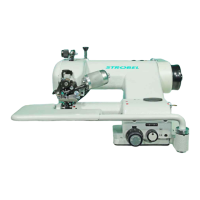22 BA_VEB100-2-4-5_A5-3_230118_en.doc
4.7 Cloth retainer (Fig. 6)
C A U T I O N ! Danger of injury!
When making adjustments in the stitch plate area, there is an
danger of injury for fingers due to accidental actuation of the
pedals!
The stitch plate is equipped with a cloth retainer. This retainer holds the sewing
material against the plunger to allow needles to insert stitches.
The cloth retainer must be set so that the sewing material cannot move as the needle
inserts stitches.
The correct positioning is important for the quality of the stitch! The pressure
of the cloth retainer against the layers of material or seam edge can be varied by
turning the screw ((1) Fig. 6a). This should be kept as small as possible
to prevent the material from developing tension or becoming marked by the pressure
between the plunger and cloth retainer. This is particularly important with delicate
materials such as velvet.
However, the pressure must still be sufficient to ensure that the sewing material
cannot move during the needle insertion.
The cloth retainer in machines equipped with a spring-loaded plunger is combined
with an adjusting screw which limits the cloth retainer's upwards stroke. This
combination is called plunger limit stop. Plunger limit stop and the spring-loaded
plunger prevent the needle from stitching through the material over cross seams and
other thicker parts and avoid markings.
The Cl.VEB100-5 (Fig. 6c) has no real cloth retainer. During the time of needle
penetration the material is hold between folder (1) and plunger (2).
The pressure of the folder on the fabric layers should be as low as possible to avoid any
twist or marks.
This is of main importance for delicate fabrics such as e.g. velvet.
Adjustment by turning knurled nut (3), depending on the set stitch depth.
The folder should be set in a way that the fabric cannot move during needle
penetration.
This setting is of great importance with regard to the sewing quality!
Correct folder setting please see “5.6.2 Sewing with folder“.

